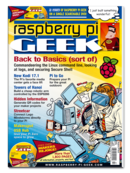Infinite Possibilities
Rita L Sooby
The open hardware movement continues to add, improve, and reinvent itself. No sooner did the Raspberry Pi Model B+ come on the scene, than the Raspberry Pi 2 debuted, adding a "1" to the name of all Rasp Pis that came before. Faster, smaller, and smarter devices appear almost daily, inspiring makers as they address ever more diverse real-world problems.
The open hardware movement continues to add, improve, and reinvent itself. No sooner did the Raspberry Pi Model B+ come on the scene, than the Raspberry Pi 2 debuted, adding a "1" to the name of all Rasp Pis that came before. Faster, smaller, and smarter devices appear almost daily, inspiring makers as they address ever more diverse real-world problems.
In this issue, our authors share their experiences monitoring environments – real and virtual, controlling systems, diagnosing problems, and extending their hardware. You discover how to take a Raspberry Pi and turn it into an infrared remote control; or, you can use the Rasp Pi to control a thunder and lightning display on a model railroad. Also, be sure to check out the overview of devices that can extend the capabilities of your Raspberry Pi.
The Arduino line of boards figures prominently, too, with a lighthearted project that creates a name badge with a small screen and a Steampunk theme. Part 2 of our Robosapien series looks at extending the number of motor drivers at your disposal to control the robot's arms, legs, and other points of movement. Another author uses an Arduino to create a climate control system for his truck using an old iPad and some servomotors.
[...]
Use Express-Checkout link below to read the full article (PDF).







